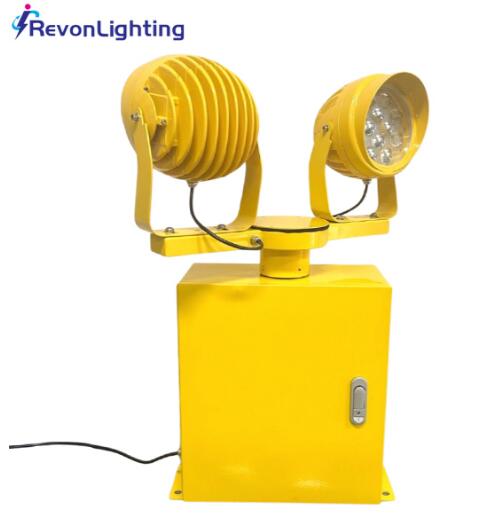Posted: 2025-06-20
Aviation operates in a world where precision is paramount, and visibility is a non-negotiable requirement. At night, in poor weather, or during low-visibility conditions, pilots rely heavily on visual cues from ground-based lighting systems. Among these, the airport rotating beacon for sale has remained a vital solution, signaling airport locations, guiding aircraft, and enhancing overall safety. For airfield operators, facility managers, and aviation infrastructure providers, understanding and selecting the right rotating beacon is essential.
What Is an Airport Rotating Beacon?
An airport rotating beacon is a ground-based lighting system designed to identify the location of an airport or heliport to pilots during nighttime or limited visibility. These beacons typically produce high-intensity, rotating flashes—either white and green (for civilian airports), white and yellow (for water aerodromes), or dual white flashes (for military installations).
Mounted on towers, rooftops, or standalone poles, these beacons provide 360-degree visibility and are visible for miles, often operating continuously during night hours or when the airfield is closed.

Why Choose an Airport Rotating Beacon?
For airfield operators, purchasing a reliable airport rotating beacon for sale means investing in both safety and compliance. Here’s why these systems remain indispensable:
Location Identification: Pilots can quickly recognize an airport’s position when flying at night or during marginal weather.
| airport rotating beacon for sale |
Compliance with Standards: Beacons meet ICAO and FAA guidelines for airfield lighting and identification.
Operational Awareness: They indicate whether the airport is in operation, providing crucial data to approaching aircraft.
Emergency Navigation: In areas with minimal infrastructure, a rotating beacon can serve as a primary navigation aid.
Components of an Airport Rotating Beacon
| airport rotating beacons for sale |
Understanding the core components can help buyers make informed decisions when reviewing any airport rotating beacon for sale:
1. Light Source
Modern beacons typically use high-intensity LEDs instead of halogen or xenon lamps. LEDs provide:
Long service life
Lower energy consumption
Reduced maintenance
2. Rotating Mechanism
The beacon rotates to create a sweeping flash effect, often between 6–12 RPM (rotations per minute). This rotation gives the light its characteristic appearance—brief, powerful flashes spaced at regular intervals.
3. Color Filters
The beam is split using colored lenses to meet identification codes:
White/Green for land airports
White/Yellow for water aerodromes
Dual White for military bases
4. Optics and Reflectors
Precision optics concentrate the beam into a narrow, powerful flash that ensures long-range visibility without scattering excessive light.
5. Housing and Mounting
Weatherproof, corrosion-resistant enclosures protect the beacon’s internal components, while mounting hardware ensures stable positioning at height.
Applications Beyond Major Airports
While typically associated with large airfields, rotating beacons are also used in various other aviation environments:
Heliports: Particularly those located at hospitals, corporate facilities, or offshore platforms.
Private Airstrips: Farm or estate owners with landing strips for personal aircraft.
Remote Airfields: In mountainous or rural regions, rotating beacons act as vital reference points.
Military and Government Sites: Ensures identification under controlled or restricted conditions.
Temporary or Emergency Runways: In disaster zones or during relief operations, portable rotating beacons aid in quick deployment.
Choosing the Right Airport Rotating Beacon for Sale
When evaluating options, key performance factors include:
1. Visibility Range
Measured in nautical miles, typical beacons are visible from 10–30 NM, depending on intensity and weather.
2. Voltage and Power Input
Some models offer dual-voltage compatibility (e.g., AC 110–240V and DC 12–48V), useful for flexibility in installations.
3. Lighting Technology
LEDs have now become the preferred standard for:
Energy efficiency
Instant-on functionality
Better environmental resistance
4. Durability
Look for features such as:
IP65 or higher waterproof ratings
Shock and vibration resistance
Temperature tolerance for outdoor conditions
5. Automation and Controls
Many advanced beacons include:
Photocell sensors for dusk-to-dawn automation
Remote ON/OFF control
Self-diagnostic capabilities for maintenance alerts
Regulatory Standards to Consider
When seeking an airport rotating beacon for sale, ensure the product adheres to standards set by:
FAA AC 150/5345-12 (U.S.)
ICAO Annex 14 (International)
EASA CS-ADR-DSN (Europe)
Compliance not only guarantees performance but also prevents legal complications and improves insurance compatibility for airfield operations.
Maintenance and Lifecycle
Though built for long-term use, rotating beacons do require regular inspection to maintain performance:
Monthly checks for lens clarity and mechanical movement
Annual servicing of bearings, rotation motors, and electrical components
Immediate replacement of light sources or modules in case of malfunction
With LED-based systems, maintenance frequency is significantly reduced, as they often last over 100,000 hours.
Modern Innovations in Rotating Beacons
The market for airport rotating beacon for sale units has evolved, integrating new technologies for greater efficiency and control:
Solar-powered models for off-grid or remote locations
Smart connectivity enabling remote diagnostics and system status
Adaptive flash intensity based on surrounding ambient light levels
Modular design for quick replacement of internal components
These innovations are not only eco-friendly but also reduce the operational cost of airfield management.
Environmental and Community Considerations
While crucial for aviation safety, rotating beacons can contribute to light pollution. Responsible implementation includes:
Directional lighting to focus beams toward the sky, not the ground
Timed operation windows to reduce unnecessary illumination
Community engagement where airports are located near residential areas
Newer models also incorporate shielding technologies and dimming features to reduce light trespass.
Investing in an airport rotating beacon for sale is more than a purchasing decision—it’s a commitment to aviation safety, compliance, and operational excellence. Whether outfitting a large commercial airport or equipping a small heliport, the right beacon ensures that pilots can identify and approach your airfield with confidence.
With advancements in LED lighting, smart control systems, and durable design, today's rotating beacons offer unmatched reliability and performance. As air traffic continues to increase and weather patterns become less predictable, these systems remain a steadfast guide—illuminating the path for every safe arrival.